
Hasegawa 1/48 P-38H Lightning
| KIT #: | 09523 |
| PRICE: | $32.95 |
| DECALS: | Two options |
| REVIEWER: | Tom Cleaver |
| NOTES: | Fundekals National Insignia |

| HISTORY |
The P-38H is an “odd duck” in the P-38 line - part P-38G, part P-38J.
The P-38F was followed in June 1942 by the P-38G, using more powerful 1,400 hp Allisons and equipped with a better radio. A dozen of the planned P-38G production were set aside to serve as prototypes for what would become the P-38J with further uprated Allison V-1710F-17 engines of 1,425 hp in redesigned booms which featured chin-mounted intercoolers in place of the original system in the leading edge of the wings, and more efficient radiators. Lockheed subcontractors, however, were initially unable to supply both of Burbank's production lines with a sufficient quantity of new core intercoolers and radiators. War Production Board planners were unwilling to sacrifice production, and one of the two remaining prototypes received the new engines but retained the old leading edge intercoolers and radiators. This became the prototype of the P-38H.
As the P-38H, 600 of these stop-gap Lightnings with an improved 20 mm cannon and a bomb capacity of 3,200 lb were produced on one line beginning in May 1943 while the near-definitive P-38J began production on the second line that August. Both the P-38G and P-38H models' performance was restricted by the intercooler system in the wing's leading edge, which had been designed for the YP-38's less powerful engines. At the higher boost levels, the new engine's charge air temperature would increase above the limits recommended by Allison and would be subject to detonation if operated at high power for extended periods of time. Reliability was not the only issue, either. For example, the reduced power settings required by the P-38H did not allow the maneuvering flap to be used to good advantage at high altitude.
The 475th Fighter Group:
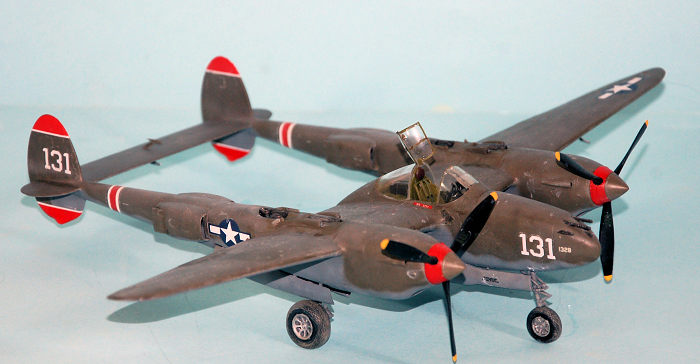 The summer
of 1943 finally saw the Fifth Air Force begin to receive the desperately-needed
reinforcement and expansion that General Kenney had argued for since his arrival
in Australia a year earlier.
The summer
of 1943 finally saw the Fifth Air Force begin to receive the desperately-needed
reinforcement and expansion that General Kenney had argued for since his arrival
in Australia a year earlier.
With 75 brand-new P-38H Lightnings just delivered from the factory in Burbank, Kenney called the 475th Fighter Group into existence on May 14, 1943, only the second fighter group to be completely created overseas after the American volunteers of the RAF Eagle Squadrons had become the 4th Fighter Group in England the previous September. The P-38H had a reputation in other units and other theaters for engine cooling problems, but Kenney was happy to get any P-38s he could; in the meantime, he kept his plans for a completely new fighter group secret since other P-38 fighter groups already in combat in North Africa and the Mediterranean were screaming for replacement aircraft and the leaders of the Eighth Air Force were begging for P-38s to provide long-range escort in England.
Originally, the unit – composed of the 431st, 432nd, and 433rd Squadrons -- was to be activated at Charters Towers in Queensland, but instead was established at Amberley Field outside Brisbane, located close to the supply depots. The group’s first commander was Major George W. Prentice, who had formerly commanded the P-38-equipped 39th Squadron of the 35th Group. A fearless fighter pilot with an excellent combat reputation, Prentice was not a “natural” in combat leadership, and would leave the responsibility for combat unit leadership to his more capable squadron commanders; his organizational skills were second to none, and he would be extremely influential in creating the unit the 475th became. Prentice’s deputy was Major Al Schinz, a combat veteran who had scored against the Japanese flying P-400s and P-39s in the 35th Fighter Group’s 40th squadron during the dark days at Port Moresby in the summer and fall of 1942.
General Kenney had to find pilots and ground crews for the group within Fifth Fighter Command, and put out word to the commanders of the other fighter groups when he ordered them to send six pilots from each of their squadrons to the new group that he wanted no “deadheads” and would hold each group commander personally responsible if the order was not followed to the letter. Thus, the 475th was well on its way to becoming the premier fighter group of the Fifth Air Force from the beginning.
Among the other newcomers who reported to the group was 1st Lieutenant Thomas Buchanan “Tommy” McGuire, Jr., who was transferred from the 49th Fighter Group’s P-38-equipped 9th squadron on July 20, a bit less than two weeks before his 23rd birthday. Five feet seven inches tall, he sported a big black mustache in an attempt to appear older. In McGuire’s case, the 49ers were both following General Kenney’s directive to send excellent pilots, and ridding themselves of a pilot they considered a misfit. By the time he came to the 475th, McGuire had acquired a reputation for being prickly and difficult to know, a man whose reputation was based on his skill in the cockpit of a P-38, not for his interpersonal skills. He had joined the USAAF as an aviation cadet on July 12, 1941. After graduation from flight school in Class 42-B on February 2, 1942, he trained as a fighter pilot with the 50th Pursuit Group at Key Field, Mississippi. From there, his first operational assignment was in the 54th Pursuit Group, based in Nome, Alaska, where he flew P-39s and honed his flying and shooting skills in the weeks following the Japanese invasion of Kiska and Attu, all the while making repeated transfer requests; his persistence finally resulted in his departing Alaska on October 16, 1942, assigned to P-38 training at Santa Ana, California, Mastering the big Lockheed twin, he received orders to the 49th Fighter Group and departed for Australia on March 14, 1943.
Shortly
after his arrival in the 49th, McGuire met Dick Bong, already known as the
hottest pilot in the Southwest Pacific; he was artless enough to let it be known
that he now had the goal of matching Bong and then bettering him, an attitude
that wasn’t considered “socially acceptable” among fighter pilots. By July, the
49ers considered themselves well rid of him when he was given orders to join the
475th’s 431st Fighter Squadron. Many years later, one of his 431st squadron
mates would remember him thus: “Tommy McGuire
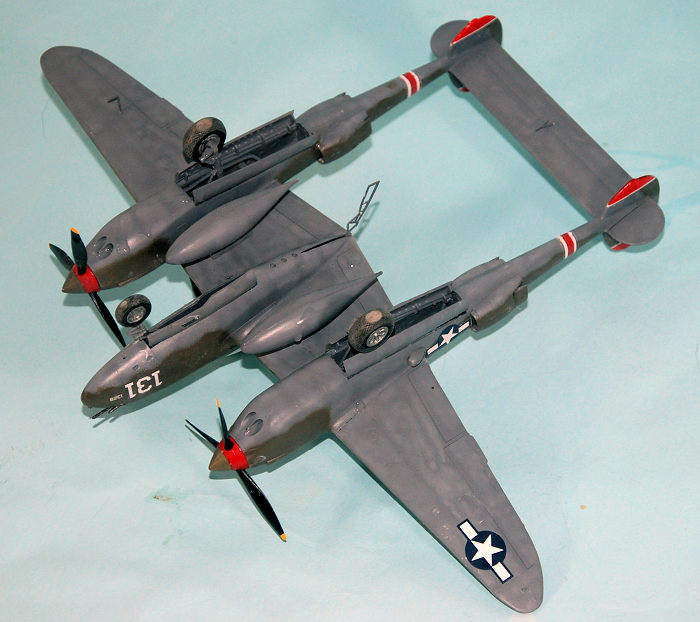 was a complete failure, socially.
But he knew more about the P-38 and how to get the most out of it, of anyone. He
could talk for hours about that airplane in great detail, to the point of
driving everyone else nuts.”
was a complete failure, socially.
But he knew more about the P-38 and how to get the most out of it, of anyone. He
could talk for hours about that airplane in great detail, to the point of
driving everyone else nuts.”
Once in the 431st, McGuire got a reputation in the squadron as a “brown-noser,” when his enthusiasm for the P-38 resulted in his appointment as squadron maintenance officer. This attitude quickly changed when aircraft availability moved up from 50 percent to over 80 percent with the ground crews’ morale rising from the inspirational leadership of a young officer who didn’t pay attention to military propriety and wasn’t afraid to get his fingernails dirty working on the airplanes with them.
On August 1, ground personnel went aboard a Liberty Ship for transport to Port Moresby, and by August 11, 1943, the 431st squadron had arrived at Twelve Mile ‘Drome, while the 432nd made its home at Ward's ‘Drome. Five days later, the 433rd Squadron arrived at Jackson ‘Drome.
The group’s first mission, an escort of C-47 transports to Tsili Tsili by the 431st squadron, set for August 12, was canceled due to bad weather, but the weather cleared enough the next day to allow 15 432nd squadron P-38s led by Danny Roberts to escort the C-47s to Bena Bene in an otherwise-uneventful mission. Two days later, the enemy was finally spotted over Lasanga Island but none of the pilots could make direct contact. On August 16, the 431st Squadron was finally blooded in combat. Escorting C-47s to Tsili Tsili, some 25 enemy fighters were spotted overhead as they dived to attack the transports. In the ensuing engagement 12 enemy aircraft were claimed shot down for a loss of two P-38s, with 1st Lieutenant Jack Mankin scoring a “Zeke” and an “Oscar.” Both were most likely Ki.43 Oscars since the Imperial Navy had no fighters in New Guinea by now, since they were fully engaged in the Solomons. Pearl Harbor veteran Harry Brown shot down three Ki.43s, which combined with his victory over Pearl Harbor and his 9th squadron victory with the 49ersmade him the first pilot in the group to become an ace.
The 475th group flew their first mission to Wewak on August 17, flying with the B-25s of the 38th group and completely surprising the enemy, who put up no aerial opposition. The next day saw a second mission to escort B-25s of the 38th group on a strafing mission to hit Dagua airdrome outside Wewak. Lieutenant McGuire, who had missed engaging the enemy during the fight at Tsili Tsili was among those assigned to the mission, flying a P-38H-5 he had named “Pudgy.” When seven Ki.43 Oscars from the 24th Sentai, nine Oscars of the 59th Sentai, five Ki.61 Tony fighters of the 68th Sentai and two Ki. 45 Nick fighters from the 13th Sentai rose to contest the American attackers this time, McGuire demonstrated his flying and gunnery skills when he attacked five Ki.43s he mistakenly identified as Zeros, shooting down four. Back at base, his wingman 2nd Lieutenant Fran Lent, also put in a claim for the fourth victory. There were no shared kills in the 475th, a coin-toss would determine who received full credit. McGuire lost, and was given credit for three, which was quite a way to lose one’s “virginity.”
Over the rest of the month, the 475th flew 16 missions to Wewak, during which they were credited with shooting down 41 enemy aircraft despite their relative inexperience. McGuire was in the forefront. On August 21, leading the 431st’s Blue Flight in “Pudgy,” with Fran Lent once again his wingman, he shot down two more Ki.43s and a twin engine Ki. 45, to become the first pilot to be credited as an ace completely within the group. On August 29, on the group’s 14th mission to Wewak, this time escorting B-24 bombers in a high-altitude attack, McGuire shot down a Ki. 43 and a Ki. 61 to bring his score to seven, tying him with 1st Lieutenant David Allen for leading ace of the group.
As he
turned away from his second victory, McGuire came under fire from another enemy
fighter and his left engine caught fire. He coolly shut down the engine and let
the propeller windmill while he dropped to 9,000 feet, which put out the fire.
Two enemy fighters followed him and he finally shook them by diving into clouds
at 4,000 feet. With the engine out, he didn’t feel able to make it back to
Moresby and so landed at the forward airstrip at Marilinan, where he
successfully landed single-engine. Future mayor of Los Angeles 1st Lieutenant
Sam Yorty, at the time intelligence officer for the 41st Fighter Squadron of the
35th Fighter Group, took down
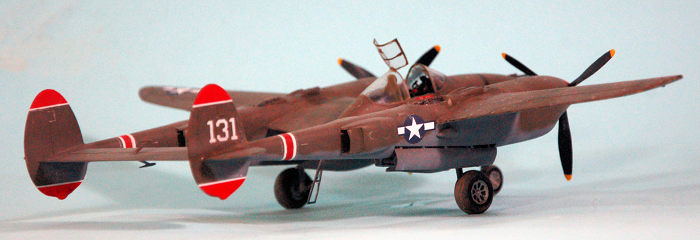 McGuire’s account of his fight with enemy pilots
he termed “both experienced and eager.” Yorty wrote a final remark in the report
to describe McGuire: “this pilot remained calm in spite of the fire in his
engine, and thereby successfully brought himself and his airplane safely to this
base.” McGuire caught a ride on a C-47 the next morning and returned to his
squadron, where he was given a P-38H-1, which he also named “Pudgy,” with the
name painted on the nose this time, above a scoreboard of Japanese flags. On
September 28, he christened the second “Pudgy” by shooting down two more Ki. 43s
over Wewak, to bring his score to nine and put him at the top of the group’s
list of aces.
McGuire’s account of his fight with enemy pilots
he termed “both experienced and eager.” Yorty wrote a final remark in the report
to describe McGuire: “this pilot remained calm in spite of the fire in his
engine, and thereby successfully brought himself and his airplane safely to this
base.” McGuire caught a ride on a C-47 the next morning and returned to his
squadron, where he was given a P-38H-1, which he also named “Pudgy,” with the
name painted on the nose this time, above a scoreboard of Japanese flags. On
September 28, he christened the second “Pudgy” by shooting down two more Ki. 43s
over Wewak, to bring his score to nine and put him at the top of the group’s
list of aces.
On October 17, 1943, McGuire's and the 431st squadron were scrambled from Dubodura to intercept a formation approaching Japanese bombers from Rabaul that were escorted by a large group of Zeros over Oro Bay. A large air battle quickly broke out. In the midst of this, McGuire saw at least seven Zeros attacking a lone P-38 that trailed smoke. McGuire turned and dived into the enemy fighters, quickly shooting down three. The four survivors turned on McGuire and severely damaged his P-38. One burst of 7.7 machinegun fire hit him in his wrist. With his controls shot up, he bailed out, but his parachute harness snagged in the cockpit. McGuire struggled to free himself as the stricken fighter fell from 12,000 to 5,000 feet until he was finally able to free himself and deploy his parachute at 1,000 feet. Landing safely in the bay, he was quickly rescued by a PT boat, where he soon found out he had three broken ribs, putting him in the hospital for six weeks. For McGuire, the fact his score put him at 12 and far ahead of any of the other aces in the group made the fight worthwhile. In recognition of his accomplishment, he was awarded a Silver Star and a Purple Heart. In late December, he was promoted to Captain and assigned as Squadron Operations Officer. Assigned a P-38H-1 that became the second named “Pudgy,” he would not score again until December 26, when he claimed four Val dive bombers shot down over Cape Gloucester. Again, his wingman also claimed one of the Vals, and with a card-cut, McGuire came out credited with three, which would be his last victories until May 1944, when his streak would resume, by which time he had been promoted to Major and risen to command the 431st.
| THE KIT |
Hasegawa’s P-38 series first arrived in shops around 25 years ago, replacing the truly elderly Monogram P-38. The series has had competition from Academy since around 1996. Come later this year, the competition is going to become intense when Tamiya releases a P-38F/G to their usual standards.
Over the years, a number of special releases of the kits have been released, as Hasegawa does with all their kits. This particular release for the “475th Fighter Group” provides decals for Tom McGuire’s third P-38H, the second one to have a name, of the 431st squadron. Decals are also provided to do Jim Ince’s “Impossible Ince” of the 432nd squadron. Both are P-38H models.
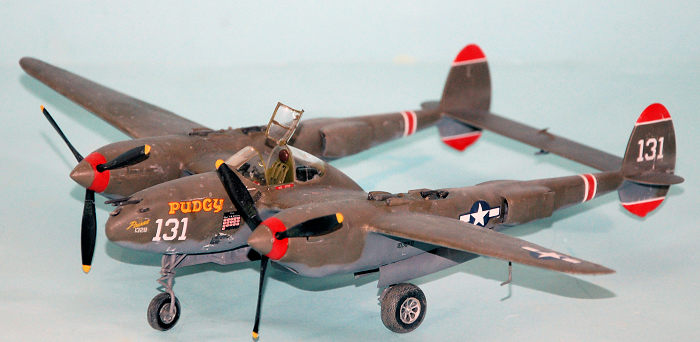 Not
mentioned by Hasegawa, but the kit as provided only allows a modeler to build a
P-38H-1. That’s because it has the same supercharger intake as the P-38F/G; the
P-38H-5 shared the “teardrop” intake one associates with the later P-48J. As
mentioned above, the P-38H is something of a “missing link” between the earlier
and later sub-types of the P-38. Fortunately, McGuire’s “Pudgy” is a P-38H-1. I
am not certain about Ince’s Lightning.
Not
mentioned by Hasegawa, but the kit as provided only allows a modeler to build a
P-38H-1. That’s because it has the same supercharger intake as the P-38F/G; the
P-38H-5 shared the “teardrop” intake one associates with the later P-48J. As
mentioned above, the P-38H is something of a “missing link” between the earlier
and later sub-types of the P-38. Fortunately, McGuire’s “Pudgy” is a P-38H-1. I
am not certain about Ince’s Lightning.
The decals are the earlier “ivory white” type associated with Hasegawa. Thus, while the personal markings are unaffected, the “131" on nose and vertical fins are this off-white. I used them anyway, and went with some of the very excellent Fundekals US National Insignia from their 1/48 release that has all versions of the “star and bar.”
I bought this kit on a whim, after hearing of the coming Tamiya kit, since I hadn’t built one of these kits in more than 20 years, and wanted to have fresh memories of so doing to compare this kit with the Tamiya kit when I review it.
| CONSTRUCTION |
I started by painting the cockpit parts Interior Green. I also cut away the molded-on sun shade over the instrument panel, which most photos of P-38s show wasn’t deployed all that often since it would force the pilot to take his eyes off the sky ahead to look under it to see the panel, rather than merely glance down. The model then needed a scratchbuilt N-9 gunsight, which I did with Evergreen rod. I also used Evergreen rod to create the throttle and propeller pitch handles. The cockpit was finished off with Eduard seat belts.
Before I closed up the cockpit nacelle, I filled the nose with fishweights. I’m a believer you can’t put too many in a P-38 kit, since so much of the model is aft of the main gear.
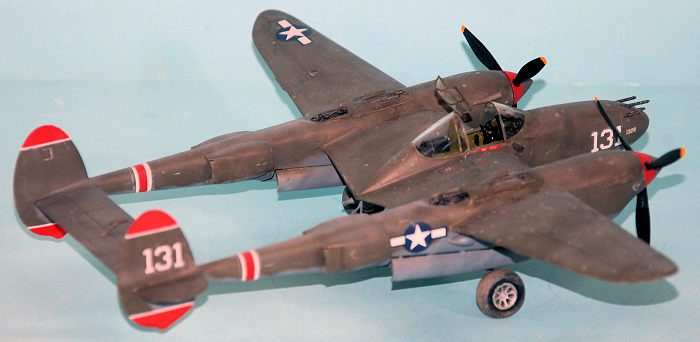 I then
turned to the engine booms. I assembled the entire landing gear, minus the
wheels, since painting the wheel wells and landing gear on a P-38H is easy:
they’re all Neutral Grey, just like the bottom of the airplane. Again, before
closing up the boom halves, I filled the front end of both with more fishweights.
I then
turned to the engine booms. I assembled the entire landing gear, minus the
wheels, since painting the wheel wells and landing gear on a P-38H is easy:
they’re all Neutral Grey, just like the bottom of the airplane. Again, before
closing up the boom halves, I filled the front end of both with more fishweights.
The Hasegawa P-38s have a reputation for being fiddly when it comes to getting them aligned, and this is true. What I did was assemble the central nacelle, which includes the entire upper wing and the lower wing area between the nacelle and the engine booms. I then attached the booms and spent some time making certain that the vertical fins were in fact vertical. I then attached the horizontal stabilizer between the booms, and set the model aside for the Tamiya Extra-Thing Cement to set up, rubberbanding the booms to the upper wing to hold them in position.
Once that was complete, I attached the outer lower wing surfaces and assembled the radiator housings. There was a need for Mr. Surfacer on the joint of the upper and lower nacelle parts, the boom centerlines, and the radiator housings, which I sanded smooth and then rescribed the panel lines. I also filled in the gas tank opening in the outer wing, since that is an item that relates to the P-38J and L, not the earlier P-38s.
I finished off by painting the windscreen clear part Interior Green on the inside, and then attaching it and the rear canopy glass.
Attaching the main gear doors is a PITA. I clipped the “hinges” so the doors fit closer, as shown in photos. This assembly area is the kit’s most difficult to get right.
| COLORS & MARKINGS |
I masked
the canopy, then preshaded the model on all the panel lines. I painted the lower
surface and the landing gear and wells with Tamiya “Neutral Grey,” then used a
OD mixture of Tamiya Flat Earth, Khaki Drab and RAF Dark Green to make late war
Olive Drab. I then lightened the paint with Flat White and went over the
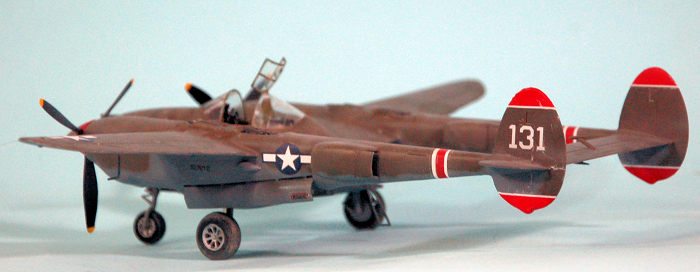 upper
surfaces, followed by putting in some Flat Yellow and going over the upper
surfaces again, to simulate sun-fading.
upper
surfaces, followed by putting in some Flat Yellow and going over the upper
surfaces again, to simulate sun-fading.
The decals went on without problem. Hasegawa provides all the stenciling in the proper size, which means the stenciling is almost invisible viewed from more than a foot away, so I applied the larger bits and took a pass on the small stuff.
I finished off with a coat of clear flat, then applied exhaust staining from the turbo exhaust along the upper rear part of the boom and the vertical fins. Photos of McGuire’s P-38H dated in December 1943 when it was relatively new show it didn’t have a lot of dings then, so I left things alone.
I unmasked the canopy. I used the “lid” from a Squadron vacuform canopy, since I could leave a “tab” at the rear that made for better attachment. The vacuform part looks better than the kit part, since it is appropriately thin. I attached the wheels and props, making certain the correct prop was on the correct boom (they counter-rotate inwards).
| CONCLUSIONS |
 The
Hasegawa kit does show its age in regards to kit design and fit, but there is no
problem associated with its construction that a modeler of average ability who
takes the problems into consideration before arriving at them cannot solve.
While photos of the Tamiya kit’s parts show things in the kit design that leave
one in no doubt that they intend to release a later P-38J/L kit (the separate
outer wing leading edges being a dead giveaway), it will probably be awhile
before that comes along. In the meantime the Hasegawa J/L can still be found at
attractive prices, and I am sure the price of the P-38F/H kits will drop among
eBay dealers (the kits are currently not in production). The various
limited-release kits have interesting decal options.
The
Hasegawa kit does show its age in regards to kit design and fit, but there is no
problem associated with its construction that a modeler of average ability who
takes the problems into consideration before arriving at them cannot solve.
While photos of the Tamiya kit’s parts show things in the kit design that leave
one in no doubt that they intend to release a later P-38J/L kit (the separate
outer wing leading edges being a dead giveaway), it will probably be awhile
before that comes along. In the meantime the Hasegawa J/L can still be found at
attractive prices, and I am sure the price of the P-38F/H kits will drop among
eBay dealers (the kits are currently not in production). The various
limited-release kits have interesting decal options.
The kit is not for a beginner, but anyone of average skill who commits to test-fitting before gluing and paying attention to alignment can have a nice-looking model of the airplane my mother always told me was the inspiration for the first word I ever said, at 11 months - “O-pane!” when a P-38 flew over the park we were in.
| REFERENCES |
History section adapted from my coming book “Under The Southern Cross: the Allied Campaign Against Rabaul.”
Tom Cleaver
5 September 2019 Copyright ModelingMadness.com. Review kit courtesy of my wallet and the kit collector
who didn’t get around to it in time. If you would like your product reviewed fairly and fairly quickly, please contact the editor
or see other details in the
Note to
Contributors.
Back to the Main Page
Back to the Review
Index Page
Back to the Previews Index Page